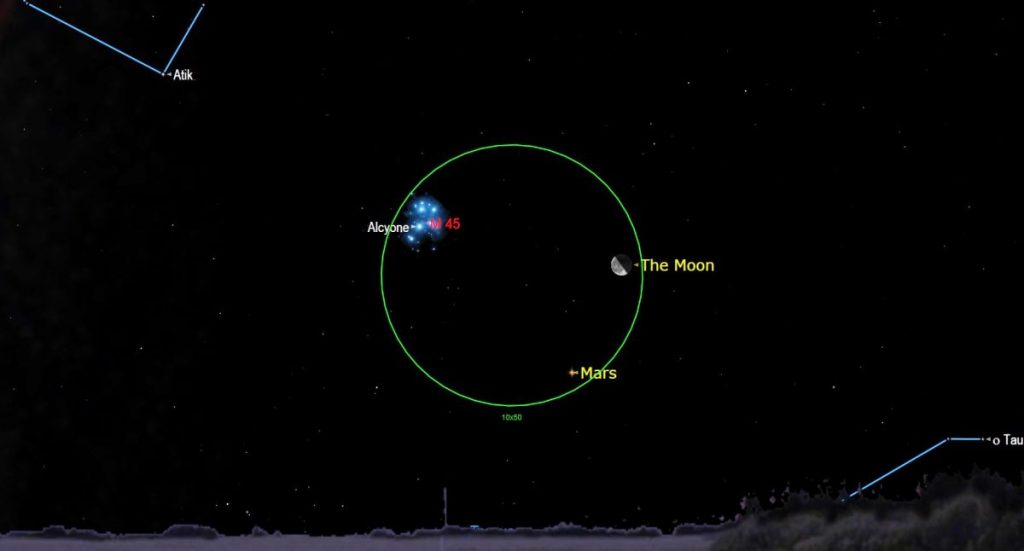Early risers on Friday (Aug. 19) morning will almost certainly take note of the last quarter (“half”) moon in the eastern sky. And floating just a couple of degrees below it will be a bright golden orange object that will be of increasing interest to skywatchers in the coming weeks and months.
The object in question is the planet Mars.
Also, in addition to the “M&M” show (moon and Mars), you can also see the famous Pleiades Star Cluster, popularly known as “The Seven Sisters,” sitting roughly five degrees to the upper left of Mars. The moon will be not quite midway between them. If you have binoculars, check this trio out; in standard 7-power field glasses you should be able to fit all three in the same field of view.
Related: See the moon hop over Uranus in the night sky on Aug. 18
And about eight degrees to the lower left of Mars is the V-shaped Hyades Star Cluster, which marks the face of Taurus the Bull. But the brightest star in the V does not belong to the Hyades at all. It’s simply an innocent bystander that just happens to be shining in the same direction as the stars in the cluster, completing the V-shape almost perfectly. That bright star also appears to glow with the same hue as Mars — golden orange. It’s Aldebaran, marking the angry right eye of the Bull.
Aldebaran ranks among the 21 brightest stars in the sky, but at this moment in time it appears only half as bright as Mars. In fact, the red planet is slowly gaining in brightness as it spends the next three and a half months approaching our Earth.
A Mars chronology
The year 2022 started out rather inauspiciously for Mars. At the beginning of the year, it was much dimmer; about one-quarter as bright as it appears now, far down near the east-southeast horizon and difficult to see against the bright dawn twilight sky.
But especially in recent weeks it has been noticeably gaining in both altitude and brightness in the early morning sky.
Back on New Year’s Day, Mars was located among the stars of the non-zodiacal constellation of Ophiuchus, having recently (on Oct. 8, 2022) passed behind the sun and then (Dec. 27) north of its “rival,” the bright red star, Antares.
Looking for a telescope to see Saturn? We recommend the Celestron Astro Fi 102 (opens in new tab)as the top pick in our best beginner’s telescope guide.
But it was not until early April after it engaged in a tight conjunction with Saturn that Mars began to rise as much as two hours before the sun and brighten to magnitude +1. On May 30, while passing very close to Jupiter, it climbed across the celestial equator into the northern hemisphere of the sky. On June 21 it arrived at the nearest part of its orbit relative to the sun, but the Earth, moving in its own orbit to catch up to Mars, was still 125 million miles (200 million km) away.
Mars crossed over from Aries into Taurus on Aug. 9 and will now remain within the boundaries of this constellation straight on through early next spring.
Currently Mars rises just before midnight and on Aug. 23 it will be 1 astronomical unit, or 92.9 million miles (149.5 million km) from Earth. On Aug. 26 it makes a right angle (called “quadrature”) with the sun and Earth and as it continues to brighten, begins to call attention to itself in the late evening eastern sky.
Ramping up
Every time Earth begins to move past Mars in our respective orbits, Mars appears to make a loop in the sky, which causes it to slow down in its eastern advance through the constellations — come to a halt — and then seemingly it moves backward, toward the west. This is known as retrograde motion and brings Mars swirling toward us as we overtake it. Mars becomes stationary on Oct. 30, and then starts its loop back to the west, which will continue until the middle of next January.
The center of this climactic time is the opposition during the overnight hours of Dec. 7-8, but because this part of Mars’s eccentric orbit slants outward, the moment of its closest approach to Earth — 50.6 million miles (81.4 million km) comes on Dec. 1.
This will be the pinnacle of the current apparition, Mars will have ramped-up considerably in brilliance, appearing more than five times brighter (at magnitude -1.8) than it does now; glowering with a steady, fiery light among the bright winter stars.
More moon rendezvous
Should skies be cloudy in your area early Friday (Aug. 18) morning, don’t fret. Each month through the balance of the year will bring other moon-Mars encounters: Sept. 16, Oct. 14-15, Nov. 10 and Dec. 7.
That final get-together will be something rather special. South of a line running roughly from Nuevo Laredo, Mexico northeast to Boston, Mars will appear to graze the lower limb of the full moon, while north of that line the moon will appear to occult or hide it; a rather rare spectacle.
Mark your calendars!
If you’re hoping to capture a good photo of the event, check out our guide on how to photograph the moon, along with the best cameras for astrophotography and best lenses for astrophotography. You can also check out our guides for the best telescopes and best binoculars to spot both the moon and Mars in the sky.
Joe Rao serves as an instructor and guest lecturer at New York’s Hayden Planetarium (opens in new tab). He writes about astronomy for Natural History magazine (opens in new tab), the Farmers’ Almanac (opens in new tab) and other publications. Follow us on Twitter @Spacedotcom (opens in new tab) and on Facebook (opens in new tab).

